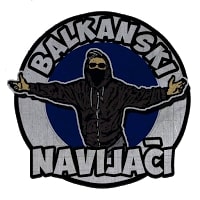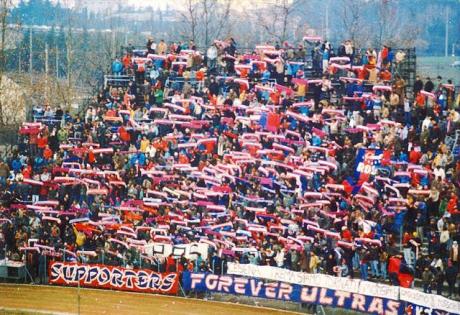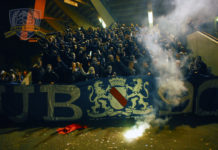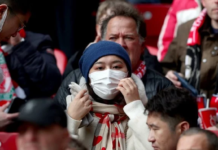The first groups of ‘ultras’, football supporters between the ages of 15 and 25 who clearly differed from the classic model of the adult football spectator, appeared in Italy around the end of the ‘sixties and early ‘seventies. Gathered in the cheaper sectors of stadiums, attracted by clubs through special reduced price subscription campaigns, the ultras immediately displayed a series of unique characteristics totally new to Italian football. These ranged from a marked sense of identification with their own particular “territory”, meaning a sector of terrace marked out by banners with the group's name or symbol, to a paramilitary look taken from the one in vogue with a number of extremist political organisations of the time: parka, Dr. Martens boots, camouflage combat suits and jackets worn under scarves with the colours of their clubs.
Initially the ‘ultras’ distinguished themselves above all for their totally new way of supporting their teams and, in a more general sense, of taking part in the match. From the Brazilian ‘Torcidas’ came the use of drums and horns, from English soccer fans the ‘scarf effect’ (massed scarves raised and waiving in a human sea-like optical effect) and chanting, more often than not obsessive, to encourage their heroes or stun and intimidate their adversaries. In this way, support came to be considered as part of the strategy and tactics used to win a match: the “twelfth player”, so as to speak. They also made widespread use of pyrotechnics (hand-held signal flares, smoke flares, rockets and coloured Bengal lights), to bring an extra touch of liveliness to the terraces. The concept of “terrace choreography” arose for the first time, a totally original practise that was to evolve as the ultra groups themselves became more organised. Choreography came to be the hallmark of the Italian style: phantasmagoric, enormous, multicoloured shows and spectacle on a vast scale, to great visual effect; the power of all-Italian fantasy. From the stage of Genoa's North Terrace that managed to inspire even the French daily “Le Monde”, to Florence's Fiesole curve that outlined the city's monuments based on the original topographic plan.
The longest standing ultra group is Milan's Fossa dei Leoni – the Lion's Den – founded in 1968, which takes the name of the black-and-red's old ground and finds home in the stadium's cheaper sectors at ramp 17. However, some date back further, like the “Fedelissimi Granata” founded in Turin as early as 1951, and still present in the ultra line-up on the Maratona curve. The Sampdoria Ultras appeared in 1969 (the first to call itself “Ultras”), followed by ‘the Boys’ from Inter. The ‘seventies saw the gradual aggregation of the hundreds of tiny groups populating the terraces of the nation's major football stadiums, leading to the formation of major groups like Verona's Yellow-blue Brigade, Fiorentina's Viola Club Viesseux, named after the piazza in Florence where they met (1971), the Naples Ultras (1972), Milan's Red and Black Brigade, Genoa's Griffin's Den and Turin's Granata Ultras (1973); the For Ever Ultras Bologna (1975), the Juventus Fighters (1975), Atalanta's Black and Blue Brigade (1976), the Eagle's Supporters Lazio and Rome's Commando Ultra Curva Sud, or ‘CUCS’ (literally the South Curve Ultras Command) (1977). Some broke away from existing clubs (the Boys were originally from Inter's Fossati Club, while the Granata Ultras split from Turin's Fedelissimi). Others arose from the fusion of smaller short-lived groups (the Juventus Fighters, for example, came from the former Panthers).
Some groups were based simply on a belonging to a certain urban area (the original core of the Sampdoria Ultras came from the Sestri Ponente quarter of Genoa), or peer group that met in Bars, schools or amusement arcades. Many of their members already belonged to political groups or movements, and it was precisely the characteristics of these politically extreme organisations, their sense of belonging and comradeship, their defiance of the powers that be and sense of conflict that gave substance to these groups, which were capable of rallying together hundreds of people in a matter of hours. Another aspect peculiar to the Ultras was their strong sense of territory. Indeed, the terraces were gradually abandoned by so-called “normal” supporters clubs, that moved their standards elsewhere to make room for the ultras’ banners. The symbols brandished on these banners were for the most part wild animals (lions, panthers and tigers in particular), the inevitable Jolly Roger, weapons and similar symbols in a call to violence (the face of little Alex, in Kubrick's film “A Clockwork Orange”). At the outset, group activities were more often than not financed by collections, with everyone chipping-in and each member having a specific function, from organising transfers to follow their club, to buying skins for drums, poles for banners and cans of paint. With the advent of the Ultras, even the excesses of the public changed face completely. Unruly behaviour like invading the pitch (or ‘referee-baiting) decreased, while from around 1974 onwards clashes between rival groups tended to become more frequent. This was the case in two matches that year: Turin-Sampdoria and Rome-Lazio. Right from the start spectators began throwing all sorts of objects onto the field, and violent battles between opposing factions of supporters ensued, obliging the police to intervene firing tear gas onto the terraces. The clashes continued onto the streets, almost in an urban warfare scenario: buses destroyed, cars overturned, etc. Many of these incidents arose from traditional rivalries (derbies between teams from the same city, or long-standing hates between rival cities, like Pisa vs. Livorno, Bergamo vs. Brescia or Palermo vs. Catania), while others depended on the political inclination of the respective supporters (the historic rivalry between Vicenza's left-wing Red Whites, and Verona's right wing Yellow-Blue Brigade).
Initially the violence was confined to a fairly limited area, meaning the stadium itself and its immediate vicinity. However, the first serious episodes were unfortunately soon to come (a stabbing during the Lazio-Naples match, the same scene being repeated during the 1975 Milan-Juventus match. In 1977 during the Atalanta – Turin match, ultras clashed with iron bars and the Inter-Milan match saw a knife fight between the Boys from Inter and Milan's Brigade). On the 28th of October 1979, during the Rome derby, a Lazio supporter, Vincenzo Paparelli, was hit in the head by a rocket fired from the south curve by a Rome Fedayn supporter, and died within a few minutes. The same Sunday saw other serious incidents in Ascoli ( Ascoli – Bologna, 7 injured), Milan (Inter – Milan, 18 injured) and Brescia (Brescia – Como, several injuries).
The Olympic stadium tragedy, aggravated by the widespread climate of violence that characterised many stadiums at the time, shook public opinion and became a major question both with the press and the authorities. Drastic steps were taken: banner poles, drums and even banners with warlike symbols were all banned from stadiums for several months. The ‘eighties saw the gradual and inexorable expansion of ultra groups whose ranks came to number not tens, but hundreds and in some cases thousands of members. There was no team, whether in the North or South of Italy, first division or third, that wasn't supported by one or more organised youth fringe groups. This proliferation naturally led to the development of a complex network of alliances and rivalries. The more solid coalitions of this period included Rome – Atalanta – Juventus, Lazio – Bari – Turin, Inter – Fiorentina – Sampdoria, Milan – Genoa – Bologna, though it's curious to note how today these relations, once cordial, have for the most part deteriorated and been replaced by other alliances, at times being transformed into atrocious rivalry. 1982 went down in history for Italy's world cup victory in Spain. The final was against Germany in Madrid, in front of a crowd of 100,000 spectators, for the most part Italian. There were also a good number of ultra banners, but this proved to be the only real moment of national level aggregation. A practically unique case in Europe if you consider the characteristic cohesion of English, German or Dutch soccer fans following their national teams. The reasons for this irreparable division between Italian supporters, unable to unite even to support the national squad, are probably rooted in the age-old rivalry between a number of the country's oldest cities. Whatever the case, the ultras nevertheless presented themselves as a continental model, giving rise to a movement that was to touch the whole of Europe. The transfer became the fundamental moment in the life of an ultra, attended only by the most fanatical supporters with no fear of the potential dangers present. The transfer became a way of selecting the group and testing the strength of the bonds within it. Being present in one of the “hot” stadiums was an honour reserved for the few. Being there without a banner was considered an act of cowardice. The increase in the travelling public on transfer days also meant considerable efforts for the State Railways, which had to schedule “special trains” for supporters. The organised spectacle of the ultras involved entire terraces, thousands of people. Buying thousands of coloured balls or pom-poms was extremely costly, but the competition for the most original show was fierce. While the Sampdoria ultras set up a 90 by 32 metre flag, the ones from Rome handed out ten thousand red and yellow cards to the public; Turin supporters covered their stadium's Maratona curve with red and white bands of cloth, and the Naples ultras were famous for hurling thousands of rolls of toilet paper onto the pitch. Hand in hand with these notes of colour went increasingly black crime reports on the violent incidents happening in stadiums. The use of knives spread, especially in Milan and Rome, while the Atalanta ultras became famous for being very turbulent but prepared to use only fists and boots.
In February ‘84 the Coppa Italia match between Triestina and Udinese ended in serious clashes with the police; a young Trieste supporter, Stefan Furlan, was beaten into a coma by police batons and died the following day. Eight months later, at the end of the Milan – Cremonese match, Marco Fonghessi was stabbed to death. The killer, Giovanni Centrone, was barely of age. On the other hand, in the early ‘eighties the link between ultras and politics began to weaken. The private cultural reaction pervading the younger ranks began to show even at the stadiums. Friendships between supporters of politically opposite inclination (Fiorentina-Verona) were further testimony to how the alliances between ultras were by then absolutely independent of any political factors. This period instead saw a steady increase in the use of drugs on the terraces. While the habitual drug addicts, frequent in the ‘seventies, disappeared thanks to increasingly severe body searches, the numbers of cannabis smokers multiplied exponentially. Even the ultra's symbolism underwent a radical transformation and images of marijuana leaves made their appearance on scores of banners. When the Nuclei Sconvolti formed in Cosenza, their name (literally subvert nuclei) was an immediate success and many groups adopted it. So, by halfway through the ‘eighties the Italian ultra movement was truly on the crest of the wave. The groups all had a multitude of followers (for example, for the 1987-88 season Milan's Fossa dei Leoni was over 15,000 strong), with a clearly defined hierarchical structure. Some groups, like the Naples Commando Ultra Curva B even had a highly evolved management structure (members filed in a database, a group house organ, a TV, etc…)..
In the ‘nineties the ultras world was overwhelmed by profound changes and began to develop an identity crisis. Many of the fundamental values that ‘being ultra’ had been based on in the past began to be felt in a different way, and far less by the incoming generations, probably because being ultra had come to be a fashion. But there was another side to the coin, that of an ultras movement which, though still unable to reach total unity of intent as a result of certain inviolable hatreds, became aware of the need to react to survive. After thirty years of history the ultras had become an integral part of the football system, irreplaceable and influential, and a determining factor even in club strategy. The second half of the ‘nineties was fatally marred by the killing of the Genoa supporter Vincenzo Spagnolo in January 1995. This devastating episode threatened the very existence of the ultras movement, already in profound crisis due to the changing generation and the dividing up of the terraces into lots of tiny “slices”, something that was made more noticeable by the disorder brought to the stadiums by the so-called “wild dogs” or scattered supporters, and due to an identity crisis which was aggravated by the disbanding of certain groups of ultras that until then had been a point of reference for many supporters, leaving them with a sense of loss and disorientation. From the ultras rally in Genoa, for which the football championships traditionally stop, came a raw-boned and crude statement inspired by the Bergamo ultras and their coarse conservative mentality, entitled “basta lame basta infami” – cut out the knives, cut out the infamy.







